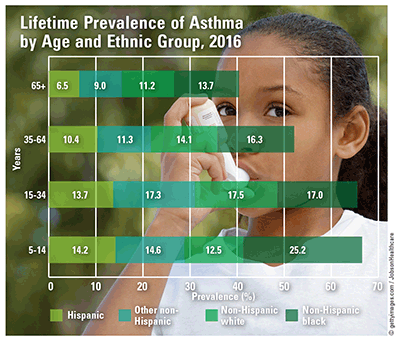US Pharm. 2018;43(7):12.
The CDC has determined that, from 2008 to 2013, asthma cost $81.9 billion per year in medical expenses and was responsible for 8.7 million missed work days, 5.2 million missed school days, and 1.1 deaths per 100,000 population. Of the estimated annual per-individual medical cost of $3,266, 56% was attributed to prescriptions.

Demographics: In 2016, 26.5 million people had asthma; 60% were female and 23% were aged younger than 18 years. Among children, asthma was more prevalent in boys, but among adults, more women than men had asthma. Although asthma was more common in women across ethnic groups, there were disparities in prevalence: non-Hispanic black women had the highest prevalence (11.8%), followed by non-Hispanic white (10.6%), Hispanic (9.1%), and other non-Hispanic women (8.4%). Prevalence initially decreased between ages 15 to 19 years and 25 to 34 years, but increased in non-Hispanic black and white women aged 35 to 64 years. In other non-Hispanic and Hispanic women, however, prevalence increased from age 15 to 19 years to age 20 to 24 years; declined in those aged 25 to 34 years; and increased in those aged 35 to 64 years.
Lifetime Prevalence: The 2016 National Health Interview Survey reported 43.3 million lifetime asthma cases; 21.6% were children (<18 years), most aged 5 to 14 years. Overall, across age groups, females outnumbered males by 19%, but among children, 36% more boys than girls were afflicted. Prevalence peaked in adults aged 35 to 64 years (16.7 million), with 52% of cases in women. Non-Hispanic blacks (17.1%) had the highest lifetime prevalence, followed by non-Hispanic whites (13.7%), other non-Hispanics (12.9%), and Hispanics (11.4%). Although lifetime prevalence was higher overall in females (14.5%) than in males (12.7%), the reverse was true for children: More boys (14.4%) than girls (11%) were affected. In those aged 15 to 34 years, non-Hispanic whites (17.5%) had the highest prevalence of lifetime asthma and Hispanics had the lowest (13.7%).
Asthma Attacks: Nearly 47% of asthma patients had asthma attacks, and attacks occurred in more females (48.4%) than males (44.8%). Children had more asthma attacks (53.7%) than adults (44.9%). Non-Hispanic black (53.1%) and white (53.9%) children had a similar frequency of asthma attacks, whereas other non-Hispanic children (63.6%) had the highest occurrence. Asthma attacks increased between ages 20 and 64 years across ethnic groups. The rate of asthma attacks was highest among non-Hispanic blacks (53.9%) and lowest among other non-Hispanics (40.9%). Among persons aged 15 to 19 years, females in all ethnic groups had more asthma attacks than males; the reverse was true in persons aged 20 to 24 years, when males outnumbered females. From ages 25 years through 64 years, asthma attacks were more common in women across ethnic groups.
To comment on this article, contact rdavidson@uspharmacist.com.






